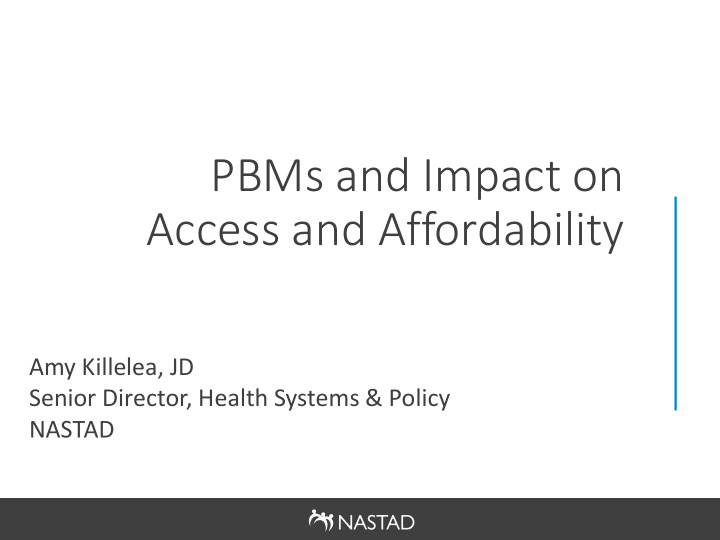



PBMs and Impact on Access and Affordability Amy Killelea, JD Senior Director, Health Systems & Policy NASTAD
1) Formulary Inclusion, UM, and Pharmacy Network Design PBMs play an outsized role in prescription drug access, including through: o P&T committee administration; evaluating clinical efficacy and clinical justification for formulary inclusion and any UM o Value committee; evaluating cost-effectiveness of formulary inclusion, tiering, and UM based on net price, including rebates o Pharmacy network design, including specialty pharmacy and mail order requirements Note: Models 22 and 74 address some but not all of these activities 2
Access Challenges Formulary inclusion Utilization Pharmacy network management Formularies exclude The use of prior Limited pharmacy drugs with a lower list authorization for certain networks and specialty price; preference cost specialty medications is and mail order over clinical efficacy increasing, and research requirements burden shows is arbitrarily patients used* * Paper forthcoming examining prior authorization applied to certain HIV medications, University of Virginia and NASTAD 3
2) Transparency Consumers need to know how much they will be paying for their prescription drugs, particularly when co-insurance is used Health plans, regulators, and consumers need to know how rebates are being spent and where they are being reinvested (each group may require different levels of information) 4
3) Affordability PBMs play a significant role in the ultimate prescription drug cost passed to the consumer Rebates generated are generally used to defray premiums, not to reduce prescription drug cost sharing for consumers (see GAO report re Medicare Part D rebates ) o This disproportionately impacts people who rely on high-cost medications, who are subject to an inflated list price when calculating pre-deductible costs and co-insurance Practices like co-pay accumulator policies put the consumer in the middle of the insurer and the manufacturer and are not a substitute for sound drug pricing reforms 5
Patient Cost Sharing for Preferred Specialty Drugs Is Unaffordable 69% of individual market silver plans use co- insurance, with a median co-insurance level of 40% o Most HIV regimens are ~$2,000/month WAC; a 40% co- insurance represents $800 per fill Less than 10% of silver plans in the individual market use co-payments that are not subject to the deductible; for those that do, the median co-pay is $550 High deductible plans are becoming more prevalent o Consumers pay list price for prescription drugs pre- deductible Source: Hempstead, K. Robert Wood Johnson Foundation, February 28, 2019 6
Manufacturer Co-pay Cards Are a Symptom of A Broken System Consumers depend on manufacturer co-pay cards to afford their deductibles and cost sharing for specialty medications Co-pay accumulators allow plans to double dip; charging the co-pay card up until its annual maximum and then charging the consumer up until the plan annual OOP maximum o CCIIO guidance announced non-enforcement of NBPP 2020 protections limiting co-pay accumulators to brand-name drugs w/generic equivalent Solution is not to remove a safety net; fix underlying problem of drug pricing and high consumer drug costs o Carl Schmid, Briefing on State Legislative and Administrative Actions to Address Prescription Drug Cost-Sharing, NAIC National Meeting (November 2018) 7
Co-pay Accumulator Impact 8
Considerations for the Subgroup Strengthen and reinforce the applicability of relevant formulary and access protections included in Model 22 Strengthen conflict of interest standards to ensure that formulary and access decisions are based on clinical justifications and not PBM self dealing Review network adequacy standards in Model 74 and ensure that pharmacy network nuances (e.g., mail order and specialty pharmacy requirements and potential abuses arising from vertical mergers) are addressed Develop transparency standards for PBM practices Ensure rebates are used to defray consumer prescription drug cost sharing, not just premiums 9
Thank you! Amy Killelea (akillelea@nastad.org) 10
Recommend
More recommend